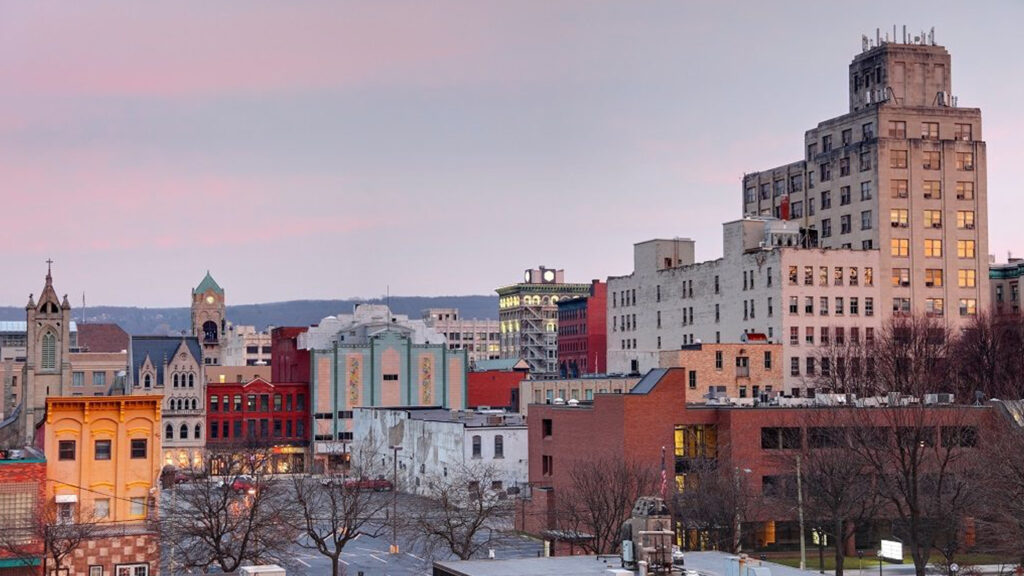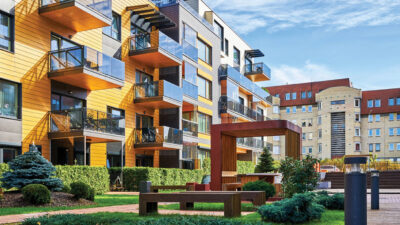Businesses continue to invest in downtown districts as people relocate to urban centers, raising the question: does this trend trickle down to smaller cities in tertiary markets and what are they doing to create their own downtown renaissance? We spoke with business, government and economic development leaders from several smaller cities in the Pennsylvania region to explore how they were faring as they plan for the future.
Wilkes-Barre
Larry Newman, the Executive Director of the Diamond City Partnership —the economic development organization for Wilkes-Barre’s CBD —compared 19th century Wilkes-Barre to a modern-day Houston but, instead of oil, coal served as the economic driver. With the decline of the coal industry, Wilkes-Barre recognized a need to reinvent its local economy.
Fortunately, the city is home to two universities —Wilkes University and Kings University —on opposite ends of downtown. The universities have both become economic engines for the creation of a mixed-use environment. Newman reported there are now more than 11,000 people working in downtown Wilkes-Barre and, given the large number of college graduates, employers are finding a ready pool of talent there. “If you are a start-up business, you get personal attention here. You are not anonymous, you are not lost in the crowd,” he said. With new housing being built in the CBD, long-term commitments to the downtown area from companies such as Guard Insurance and local tech company Pepper Jam, proximity to major metropolitan markets and a low cost of living, Newman believes Wilkes-Barre is experiencing a renaissance. “We have a collection of assets that allow residents to have a fantastic quality of life and people are starting to notice,” he said.
Wilmington
Over the years, Wilmington’s reputation as a corporate headquarters capitol has shifted industries from chemical companies to financial services. The loss of MBNA Corporation, the state’s largest employer, and reputation as a 9 to 5 city has seen Wilmington struggling with office vacancy. However, Rob Buccini of the Buccini/Pollin Group is working to change the city’s trajectory. “Our goal is to have 5,000 people living in downtown Wilmington and at the riverfront by 2020,” he said.
With the addition of a strong residential community, Buccini reports, “The companies are following.” An example of this was the recent decision by Chemours to stay in Wilmington because of its central location to its workforce. Wilmington Mayor Mike Purzycki reports that more than 50,000 people work in Wilmington every day. He is hopeful that the renewed emphasis on expanding luxury residential options in the downtown —there are currently nearly 1,000 residential units being built—will propel growth. He’s seen it happen before.
As the former head of the Riverfront Development Corporation, Purzycki led the successful $1.5 billion redevelopment of the riverfront district and has seen more than 1,500 people move there in the last five years. He’s confident this can be replicated in other parts of the CBD and, as a result, an educated talent pool will follow. “The financial situation (here) is very good, business taxes are low and we have a growing downtown residential and restaurant scene now,” he said.
One success has been The Mill, a premier co-working space that began with 10,000 square feet of space a year ago. Now it’s expanding to 45,000 square feet to accommodate the demand from entrepreneurs. Buccini/Pollin is planning a 12,000-square-foot industry-chic food hall and community space as well as a restaurant/brew pub with residential above.
Among Wilmington’s attractions for businesses, the city boasts the fastest internet speed in the country, the eleventh busiest train station in the nation, a pro-business mayor and invested private developers. Wilmington has the potential to rebound into the thriving city it once was. “Wilmington is certainly not in the ninth inning but we’re in the sixth and have started to accelerate,” said Buccini.
Scranton
For many years, Scranton was known as the home of Dunder Mifflin, the fictional paper supply company where the hit comedy The Office was set. The small industrial city enjoyed national exposure and a boost in tourism during the show’s run. These days the Electric City (America’s first electric-operated trolley system was developed here), is getting national attention from outside investors and the town is undergoing what some are calling a rebirth.
Amy Luyster of the Greater Scranton Chamber of Commerce, has personally witnessed this revival. “We’re getting national exposure and an increase in investment coming our way from out of market,” she said. Scranton still struggles with office vacancy but has experienced an explosion of healthcare activity downtown and growth in the eds and meds sectors. The city is home to the University of Scranton which offers one of the leading pre-med programs in the country. The Geisinger Commonwealth School of Medicine opened in downtown Scranton several years ago and continues to attract young professionals to the area.
Developers have sensed opportunity in Scranton and at the forefront of this renaissance is developer Charlie Jefferson of Jefferson-Werner, LLC. He took a risk in 2010 when he redeveloped the Connell building on Washington Avenue into a mix of 89 apartments with three floors of office and retail space. Jefferson points to the pro-business attitude of the state and local government and various tax credits for making projects like this feasible and successful. More importantly, he emphasized there has been a snowball effect which he describes as “one project leads to another and to additional developers and business owners looking for opportunities in the Scranton CBD.”
The Scranton Chamber of Commerce is busier than ever and is on target to have more than 5,000 jobs created and retained within the next three years. In early 2017, the city of Scranton made national television again whenne of their local incubator tenants, DARTDrones, was selected to pitch their drone training school concept on the reality television show Shark Tank. The pitch was a success and the business is one of many small entrepreneurial companies thriving in Scranton today.
Allentown
Few cities have seen as dramatic a turn-around in their downtown district as Allentown. Much of this transition is due to the implementation of the Neighborhood Improvement Zone (NIZ). The NIZ was created in 2009 by the Pennsylvania State Legislature and, as Steve Bamford, Executive Director of the NIZ District Authority explained, “It’s a unique financing tool that is only available in Allentown. Certain state and local taxes that are generated by existing and new businesses can be applied to debt service on capital improvements in the zone.”
The taxes are rebated to tenants resulting in drastically reduced rental rates. As Bamford reported, the NIZ “has experienced over half a billion dollars of development completed in the last several years.” This has attracted Lehigh Valley companies who were tenants outside the NIZ and who are now experiencing significant savings by relocating within the zone. Major companies such as BB&T Bank and the Lehigh Valley Health Network were early proponents of the NIZ and, most recently, Talen Energy announced they will relocate within the city to take advantage of this opportunity.
J.B. Reilly, CEO of Center City Investment Corporation, has been the prime driver in the creation of the NIZ. “Everything we are doing in terms of planning is really about creating a place where people want to be,” he said. Reilly’s company has constructed more than 300 new apartments in the CBD with plans to have more than 1,000 units within the next five years. This activity, coupled with a new hotel, new restaurants, retail spots and a multi-purpose arena proves downtown Allentown is quickly emerging as a vibrant city that has become a model for the “live, work, play” philosophy. While expanding the renaissance beyond the NIZ remains a challenge, Reilly is bullish on the city and proud of the hope and optimism that is permeating throughout the CBD.
Significant challenges abound for any urban community trying to develop neighborhoods around the central business district. As rents in the larger metropolitan markets continue to rise, additional demand will likely spread to tertiary markets. These cities are poised for growth. They demonstrate a genuine collaboration between local and state government, the business community and the real estate community and a healthy sense of optimism that the best days are ahead. This requires patience and a willingness to take risks. The cities we analyzed are in different stages of success, but they are positioned to introduce the downtown districts to a new generation of businesses and residents.

 John Susanin
John Susanin

 Aaron Jodka
Aaron Jodka
